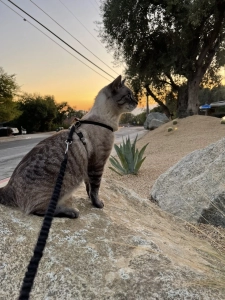Indoor living is best for cat longevity, but ‘catios’ are fun and walking on leash is doable

Mister, a leash-trained cat, enjoys going for walks with his owner, Bonnie. Walking your cat on a leash and harness is a safe way for cats to experience the outdoors.
With kitten season in full swing, shelters across Southern California are full of adorable and adoptable cats and kittens looking for new homes. During our adoption counseling sessions, we are often asked if cats should live strictly indoors.
For the health and safety of cats, as well as wildlife, we recommend that cats be kept indoors and only be allowed outside if on a leash or in an enclosure.
I know many of you are thinking, how the heck am I going to get my cat accustomed to a leash, and are my neighbors going to think I’m crazy?
Well, I assure you, walking your cat is totally in vogue. My friend Bonnie walks her cat Mister every day. Luckily for the fashionable, our Pasadena Humane website has an easy instructional video on leash training your cat.

Mister, a leash-trained cat, enjoys going for walks with his owner, Bonnie. Walking your cat on a leash and harness is a safe way for cats to experience the outdoors.
And just google “catios” to see some wonderful images of outdoor cat enclosures from the simple to the sublime. Outdoor playpens for cats are another option for giving your cat some safe and fun outdoor time.
Keeping your cat indoors or enclosed helps them live a longer life. By some estimates, indoor cats live an average of 10 to 15 years, while the average lifespan of an outdoor cat is just three to five.
Outdoor risks for cats abound — cars, predatory wildlife, people who are unkind to cats, cats who fight with other cats, communicable diseases, parasites, toxins, and the list goes on.
Indoor cats may avoid these outdoor dangers, but the downside is they are more likely to be overweight and suffer from boredom. That’s why physical activity and mental enrichment are just as important for cats as for dogs.
The good news is, in addition to leash walking and outdoor enclosures, there are many simple ways to provide enrichment and activity for your indoor cat.
Here are a few of my favorites:
Get Vertical: Cats are natural climbers. Give your little Tigger some vertical space by supplying climbing and scratching surfaces such as cat trees and wall-mounted cat shelves.
Indoor gardening: Bring the outdoors inside by growing cat grass for your feline companion. You can pick up pre-grown grass or seed mixes at your local pet store. No green thumb? No problem. Get some dried catnip to sprinkle around your cat’s play area.

Mister, a leash-trained cat, enjoys going for walks with his owner, Bonnie. Walking your cat on a leash and harness is a safe way for cats to experience the outdoors.
Play: Indoor cats get most of their exercise from play. It’s important to provide your cat with a few 10-to-15-minutes of daily play sessions. Most cats love chasing a wand toy. Have it resemble prey by making the toy disappear around the corner and watch your cat pounce. I recommend these types of toys, rather than laser pointers, so your cat can have the satisfaction of actually “catching” something tangible.
Soak in the sun: Cats love to nap in the sunshine. Provide your cat with a variety of cozy beds, window perches and window-level cat trees so they can soak in some rays, while engaging in wildlife-friendly bird watching.
Scratch that: Scratching is a normal, healthy cat behavior and should be encouraged. Cats scratch to express emotions, mark their territory, keep their nails healthy and stretch. To prevent your cats from scratching furniture, provide them with a variety of appropriate scratching options. Try a combination of vertical and horizontal scratchers made of different materials to discover what your cat likes best.
Despite the jokes we’ve all heard — especially during the pandemic — about cats being anti-social and wanting less time with their humans, cats can be wonderfully social and lots of fun.
Please consider bringing one, or another, into your family. And if you’re on the lookout for more cat care tips, visit Pasadena Humane’s new behavior and training resource library at pasadenahumane.org/behavior
Dia DuVernet is president and CEO of Pasadena Humane.
This blog post originally appeared as a column in the Pasadena Star-News on August 5, 2022.


